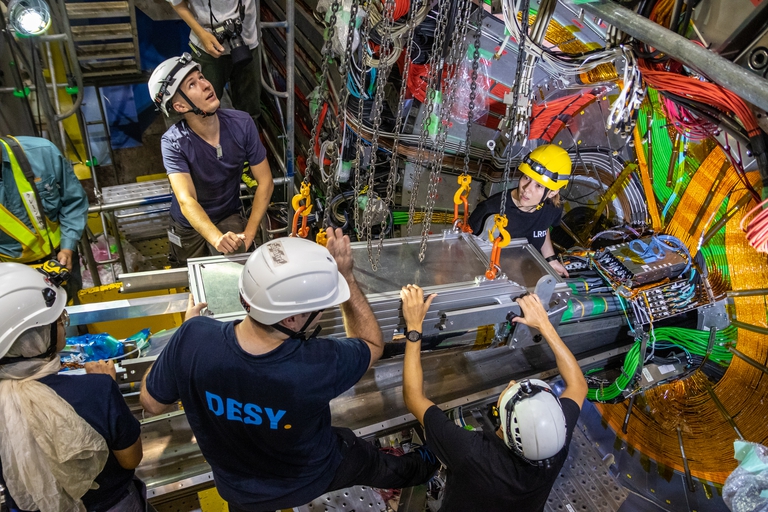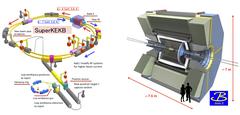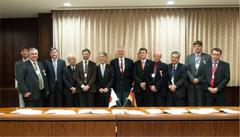KEK is upgrading its B-factory to the SuperKEKB facility (left) to provide a 40-fold increase in instantaneous luminosity by exploiting higher beam currents, a large crossing-angle and squeezing the beams down to nanometre scales. Also the former Belle detector needs to be upgraded to Belle II (right) to cope with the enormous increase in intensity.
Belle II
Joining the hunt of flavour
Joining the hunt of flavour
Joining the hunt of flavour
Opportunities
DESY@BELLE I/II offers diverse opportunities for Bachelor, Master, and PhD theses both in physics analysis or in one of the technical projects of the group.
If you are interested please contact our group leader:
phone: +49 40 8998-3445
Further contacts:
b->sll: Alexander Glazov
Pixel Detector PXD: Maiko Takahashi and Daniel Pitzl
Radiative B Decays: Kerstin Tackmann
Tau Physics: Ami Rostomyan
Time Dependent CP Violation: Thibaud Humair
Secretariat
The Belle II Experiment
For 40 years DESY enjoys a very fruitful partnership with research institutions in Japan. The close cooperation began with Masatoshi Koshiba at the DORIS experiment DASP. The collaboration then developed further with Japanese participation in JADE, ZEUS and HERMES and within the combined efforts for the ILC. Since the year 2011 DESY is member of the international Belle II collaboration (see map) and engages in preparations for a very ambitious experiment, which will be operated at the Japanese High-Energy Accelerator Research Organisation KEK in Tsukuba close to Tokyo. This experiment at the intensity frontier exploits properties of B-mesons, which in the year 1987 for the first time were measured at the DORIS experiment ARGUS and will address some of the fundamental questions in particle physics today.
Super KEKB and Belle II
From 1998 to 2010, KEK, the Japanese High-Energy Accelerator Research Organisation, operated KEKB, a 3 km circumference asymmetric electron–positron collider thereby reaching the world record in instantaneous luminosity of 2.11x1034 cm–2 s–1. The beam energies were chosen such, that in the collisions mainly B-mesons were produced, which is the reason why the facility is also known as B-factory. The Belle experiment precisely analysed the characteristics of pairs of B- and anti-B-mesons and confirmed the effect of CP- violation as described by the theory of Makoto Kobayashi and Toshihide Maskawa, who both were awarded the Nobel prize in physics in 2008. CP-violation is believed to be one of the origins for the observed dominance of matter over anti-mater in our present universe. However the measured level of CP-violation is by far not sufficient to quantitatively explain the actual asymmetry. Therefore, a much deeper understanding of the related phenomena is required.
SuperKEKB (figure 1 left) is an upgrade project at KEK to increase the instantaneous luminosityto 6x1035 cm–2 s–1. The next-generation B-factory will complement the exploration of New Physics beyond the Standard Model currently being carried out at the energy frontier by the experiments at the Large Hadron Collider (LHC). While the LHC experiments provide a direct probe of the TeV mass scale, high-precision measurements of rare decays and CP-violation in heavy quarks and leptons provide a unique probe of New Physics at these and even higher mass scales through the effects of new particles in higher order processes. In the past, measurements of processes involving internal loops have given access to high mass scales before accelerators were available to directly probe these scales.
Reaching higher luminosity in a collider usually involves both increasing the beam current and reducing the beam size at the interaction point. The original approach for the upgrade focussed on an increase of the beam currents and the beam– beam parameter – the high current option. However, in March 2009 the SuperKEKB design changed course based on ideas of Pantaleo Raimondi from the Italian SuperB project, using a large crossing-angle at the interaction point and squeezing the beams to nanometre-scale to increase luminosity – the nano- beam option. The ambitious goal is to accumulate an integrated luminosity of 50 ab–1 which is 50 times more data than the previous Belle detector acquired, after another upgrade of the accelerator and the final focus system as well as the Belle II detector.
Since August 2012 DESY is also member of the Belle collaboration and participates in the analysis of the collected Belle dataset.
Since November 2011 DESY is also official member of the Belle II collaboration. At the occasion of the groundbreaking ceremony for the SuperKEKB project, which took place on November 18 at KEK, representatives of DESY and of the other German institutes signed a corresponding memorandum of understanding with KEK (figure 2).



